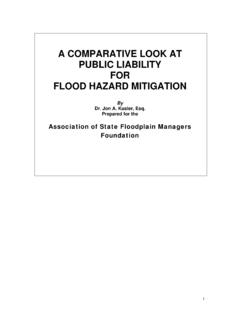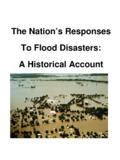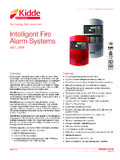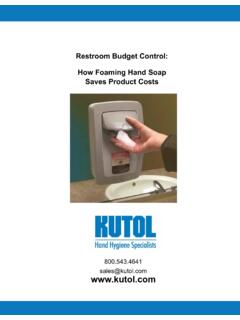Transcription of NATURAL HAZARD MITIGATION SAVES: An Independent …
1 NATURAL HAZARD MITIGATION SAVES: An Independent Study to Assess the Future Savings from MITIGATION Activities Volume 1 Findings, Conclusions, and Recommendations THE MULTIHAZARD MITIGATION COUNCIL The Multihazard MITIGATION Council (MMC), a council of the National Institute of Building Sciences (NIBS), was established in November 1997 to reduce the total losses associated with NATURAL and other hazards by fostering and promoting consistent and improved multihazard risk MITIGATION strategies, guidelines, practices, and related efforts. The scope of the Council s interests is diverse and reflects the concerns and responsibilities of all those public and private sector entities involved with building and nonbuilding structure and lifeline facility research, planning, design, construction, regulation, management, and utilization/operation and the hazards that affect them.
2 In recognition of this diversity, the Council believes that appropriate multihazard risk reduction measures and initiatives should be adopted by existing organizations and institutions and incorporated into their legislation, regulations, practices, rules, relief procedures, and loan and insurance requirements whenever possible so that these measures and initiatives become part of established activities rather than being superimposed as separate and ad-ditional. Further, the Council s activities are structured to provide for explicit consideration and assessment of the social, technical, administrative, political, legal, and economic implications of its deliberations and recommendations. To achieve its purpose, the Council conducts activities and provides the leadership needed to: Improve communication, coordination, and cooperation among all entities involved with MITIGATION ; Promote deliberate consideration of multihazard risk reduction in all efforts that affect the planning, siting, design, construction, and operation of the buildings and lifelines systems that comprise the built environment; and Serve as a focal point for the dissemination of credible information and sage counsel on major policy issues involving multihazard risk MITIGATION .
3 MMC Organizational Members American Forest and Paper Association, Washington, ; American Institute of Architects, Washington, ; The American Red Cross, Washington, ; Association of State Dam Safety Officials, Lexington, Kentucky; Association of State Floodplain Managers, Inc., Madison, Wisconsin; Consortium of Universities for Research in Earthquake Engineering, Richmond, California; Council on NATURAL Disaster Reduction/American Society of Civil Engineers, Reston, Virginia; Earthquake Engineering Research Institute, Oakland, California; Factory Mutual Insurance Company, Norwood, Massachusetts; French and Associates Ltd., Park Forest Illinois; GE Global Asset Protection Service, Hartford, Connecticut; IBM, Woodland Hills, California; Institute for Catastrophic Loss Reduction, Toronto, Ontario, Canada; International Code Council; Johns Hopkins University Applied Physics Laboratory, Laurel, Maryland; Multidisciplinary Center for Earthquake Engineering Research, State University of New York at Buffalo, New York; National Fire Protection Association, Quincy, Massachusetts; National Fire Sprinkler Association, Patterson, New York; National Institute of Standards and Technology, Building and Fire Research Laboratory, Gaithersburg, Maryland; NATURAL Hazards Center, University of Colorado, Boulder; Portland Cement Association, Society of Fire Protection Engineers, Bethesda, Maryland.
4 State Farm Fire and Casualty Company, Bloomington, Illinois; Tennessee Building Officials Association, Murfreesboro, Tennessee; The Thornton - Tomasetti Group, Inc., New York, New York; Zurich , Schaumburg, Illinois MMC Affiliate Members Baldridge & Associates Structural Engineering, Inc.; Corotis, Ross, Boulder, Colorado; Goettel and Associates, Inc.; Martin and Chock, Inc., Honolulu, Hawaii The Multihazard MITIGATION Council, a council of the National Institute of Building Sciences NATURAL HAZARD MITIGATION SAVES: An Independent Study to Assess the Future Savings from MITIGATION Activities Volume 1 Findings, Conclusions, and Recommendations Prepared with funding from the Federal Emergency Management Agency of the Department of Homeland Security by the Multihazard MITIGATION Council of the National Institute of Building Sciences with the assistance of the Applied Technology Council National Institute of Building Sciences Washington, 2005 ii NOTICE: Any opinions, findings, conclusions, or recommendations expressed in this publication do not necessarily reflect the views of the Federal Emergency Management Agency.
5 Additionally, neither FEMA nor any of its employees make any warranty, expressed or implied, nor assume any legal liability or responsibility for the accuracy, completeness, or usefulness of any information, product, or process included in this publication. This report was prepared under Contract EMW-2003-CO-0417 between the Federal Emergency Management Agency and the National Institute of Building Sciences. It is based on concept development and analytical work conducted under Contract EMW-1998 CO-0217. For further information, visit the Multihazard MITIGATION Council website at or contact the Multihazard MITIGATION Council, 1090 Vermont, Avenue, , Suite 700, Washington, 20005; phone 202-289-7800; fax 202-289-1092; e-mail In Memoriam The Multihazard MITIGATION Council wishes to acknowledge James M.
6 Delahay, PE, for his contributions to the Applied Technology Council s research/analysis efforts and his significant contributions to the profession of structural engineering and the nation s codes and standards development efforts. The built environment and all those who use it have benefited tremendously from his work. iii PREFACE The National Institute of Building Sciences through its Multihazard MITIGATION Council is pleased to submit this report to the Congress of the United States on behalf of Federal Emergency Management Agency (FEMA) and the Department of Homeland Security. This report presents the results of an Independent study to assess the future savings from HAZARD MITIGATION activities. This study shows that money spent on reducing the risk of NATURAL hazards is a sound investment.
7 On average, a dollar spent by FEMA on HAZARD MITIGATION (actions to reduce disaster losses) provides the nation about $4 in future benefits. In addition, FEMA grants to mitigate the effects of floods, hurricanes, tornados, and earthquakes between 1993 and 2003 are expected to save more than 220 lives and prevent almost 4,700 injuries over approximately 50 years. Recent disaster events painfully demonstrate the extent to which catastrophic damage affects all Americans and the federal treasury. The MMC Board wishes to acknowledge the efforts of its subcontractor, the Applied Technology Council (ATC), and the dedicated, innovative, and painstaking work of the ATC research team The MMC Board also recognizes the Project Management Committee established to oversee the project on its behalf. The committee members spent countless voluntary hours reviewing study materials and providing guidance to the MMC subcontractor conducting the data analysis effort, and the MMC Board thanks them very much for their extraordinary contribution of time and expertise.
8 The MMC Board also is grateful to the superb MMC staff and its project management consultant, who worked closely with the Project Management Committee and served as technical liaison with the ATC researchers. Further, the MMC wishes to thank the FEMA personnel and state and local officials who provided data and other information for analysis in this study. The MMC also wishes to express its gratitude to FEMA for having the confidence in the Council to give it the independence needed to conduct the study and prepare this report and especially to Maria Vorel and Margaret Lawless of FEMA for their insight and support. Brent Woodworth Chair, Multihazard MITIGATION Council iv v TABLE OF CONTENTS PREFACE .. iii OVERVIEW .. 1 FINDINGS AND 5 MMC BOARD RECOMMENDATIONS .. 7 PROJECT 9 vi 1 OVERVIEW The Multihazard MITIGATION Council (MMC) of the National Institute of Building Sciences (NIBS) conducted this Independent study to quantify the future savings from HAZARD MITIGATION activities in response to a mandate by the House Appropriations Committee, Subcommittee for the Veterans Administration, Department of Housing and Urban Development, and Independent Agencies of the 106th Congress (House Report 106-161): The Committee recognizes that investing in MITIGATION will yield reductions in future disaster losses and that MITIGATION should be strongly promoted.
9 However, an analytical assessment is needed to support the degree to which MITIGATION activities will result in future savings. Therefore, the Committee directs FEMA to fund an Independent study to assess the future savings from the various types of MITIGATION activities. The study was based on a detailed work plan formulated by a team of experts established by the MMC Board. Although funding for the study was provided by the Federal Emergency Management Agency (FEMA), the study was conducted independently of FEMA. The study assumptions were generally conservative that is, where appropriate, parameters and methods were chosen to produce lower estimates of future savings. Sensitivity analyses on key variables indicate the results are robust. More than 50 national experts in a wide variety of disciplines participated in the project.
10 Study methods and results were reviewed by two separate groups of Independent experts on an ongoing basis. (See the list of participants at the conclusion of this report.) The study was structured to quantify the future savings (in terms of losses avoided) from HAZARD MITIGATION activities related to earthquake, wind, and flood funded through three major NATURAL HAZARD MITIGATION grant programs (the HAZARD MITIGATION Grant Program, Project Impact, and the Flood MITIGATION Assistance Program).1 Two types of MITIGATION activity were addressed: project mitigations, which include physical measures to avoid or reduce damage from disasters (such as elevating, acquiring, or relocating structures threatened by floods and strengthening structures to resist earthquake and wind forces) and process mitigations, which include activities that lead to policies, practices, and projects that reduce risk and loss ( , assessing vulnerability and risk, educating decision-makers, and fostering adoption of strong building codes).














